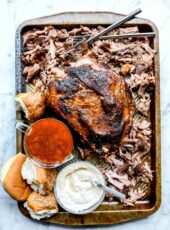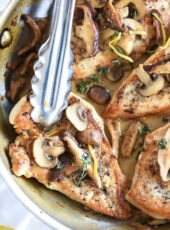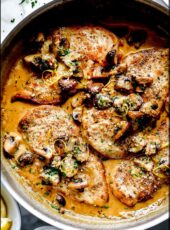Served over pasta or layered in lasagna, this slow-simmered, authentic bolognese sauce with its deep, rich, meaty flavor is an Italian classic that makes enough for dinner tonight and leftovers tomorrow.
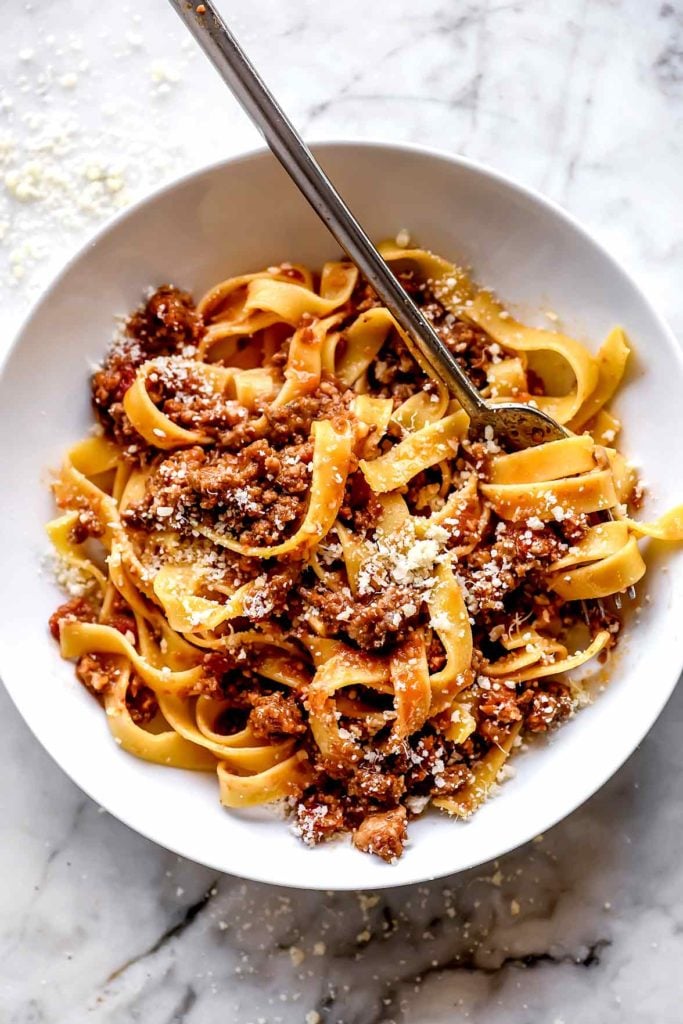
If you took a look around the internet for the best bolognese sauce recipe, you’d find a list as long as your arm. Bolognese is a staple in classic Italian cuisine, right up there with pasta puttanesca, carbonara, and pasta alla Norma. And like so many classic recipes, this traditional Italian meat sauce is known in Italy as salsa alla bolognese, sugo alla bolognese, or ragu bolognese, and has plenty of “rules” to what deems it authentic. But the one thing most everyone can agree on is that while authentic bolognese sauce isn’t hard or expensive to make, time and patience are the most important ingredients needed for developing its lush, deep, meaty flavor. And because this meaty sauce clings rather than coats swirls of pasta, this is the best bolognese sauce recipe you’ve been looking for.
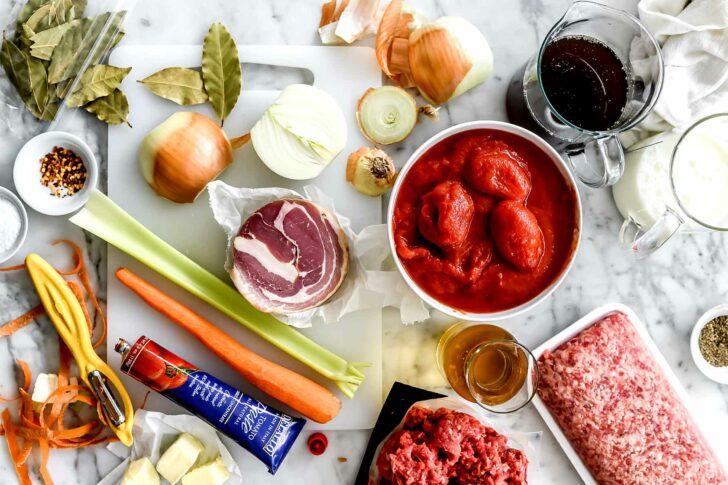
In This Post
What Makes a Bolognese a Bolognese Sauce?
Bolognese is a mildly flavored meat sauce with a bit of tomato, not a tomato sauce with meat. It’s often served over long pastas such as pappardelle, tagliatelle, or fettuccine, or layered in lasagna. Ever since visiting Italy, I’ve been working on my bolognese pronunciation, and hot dang, I think I’ve almost got it! Originating in Northern Italy, the dairy used in French cooking influenced this recipe, where butter and milk are added both for flavor and to tenderize the three different types of meat used in it. Wine, either red or white, is also simmered into the meat to tenderize and flavor the sauce.
The truly classic recipes such as this one certified official ragù alla bolognese recipe by the Accademia Italiana della Cucina, skips canned tomatoes altogether, opting only for tomato paste to fill the bill. But thanks to the popularity of recipes by Italian cookbook authors like Marcella Hazan, the addition of tomatoes is more common and makes a supremely versatile sauce.
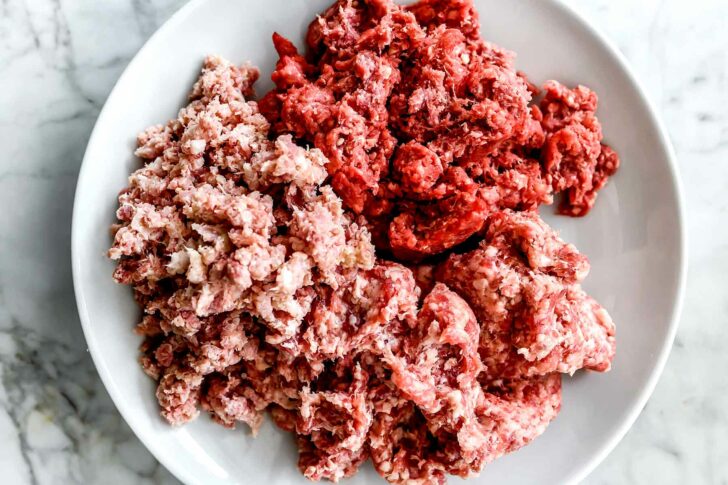
What’s in This Bolognese Sauce Recipe
- Ground beef. For maximum flavor, save the low-fat meat for another time. In this rich sauce, fatter cuts of meat balance the acidity of the tomatoes. Choose an 80/20 ground chuck, or boneless beef short ribs you coarsely grind in the food processor yourself. Ground veal can be used as well.
- Ground pork. Fat equals flavor so don’t skimp on either. If grinding the pork yourself, choose a boneless pork shoulder.
- Pancetta. Similar to bacon in the U.S., pancetta is a salt-cured pork belly that adds depth and richness to recipes. Some bolognese recipes call for diced pancetta, but I prefer ground pancetta for a bite that’s more in keeping with the other ground meats instead of crispy nuggets. Purchase a block of pancetta from the deli and grind it in the food processor yourself.
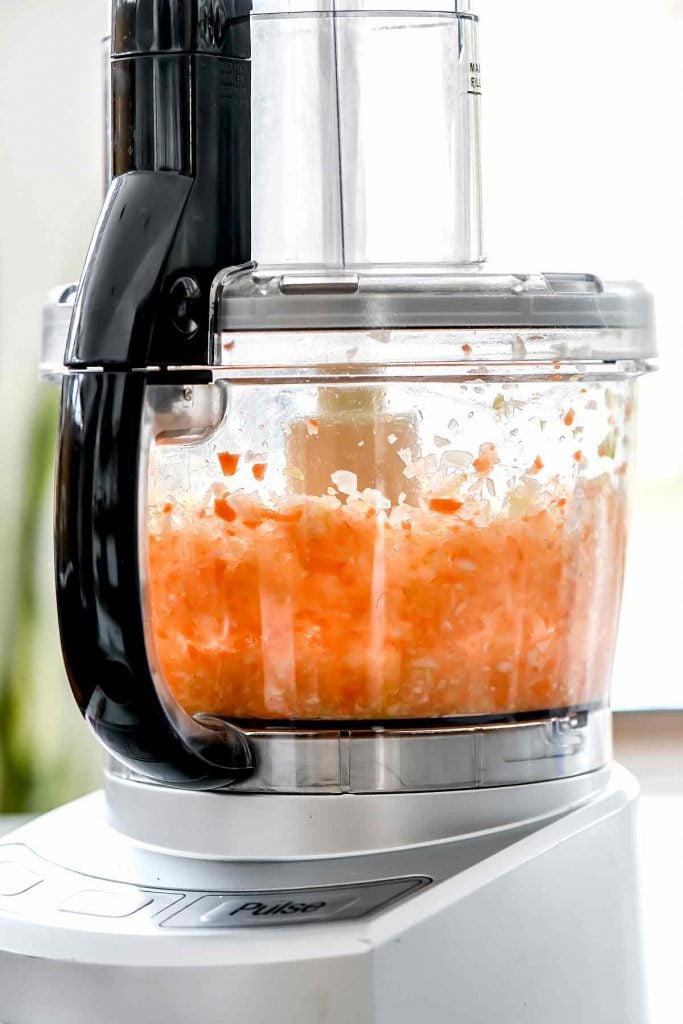
How to Make Bolognese Sauce Taste Better
- Onion, celery and carrot. Imparting flavor but not texture, once this sauce is cooked you’ll never even know a vegetable was added to it. The key is that they melt into the meat when cooked. Roughly chopped and then added to the food processor, minced veggies create the mirepoix, or Holy Trinity of flavors for the base of this sauce. If you don’t have a food processor, use a grater or finely mince the veggies instead.
- Bay leaves and red pepper flakes. It’s amazing how much flavor is created with just these two simple ingredients. Save the garlic and other herbs for other pasta sauces another time.
- Skip the garlic. There’s no garlic in authentic bolognese. Save it for recipes like my favorite marinara or Pomodoro sauce.
Bolognese Meat Tenderizers
- Wine. Wine’s acidity is added after browning but before the tomatoes tenderize the meat while building flavor. But which wine is best? White or red? The debate goes on. With its less pronounced flavor, I prefer white wine in bolognese sauce, but either will do. Just make sure it’s a decent brand you wouldn’t mind drinking. Sherry wine works as well.
- Butter and milk. Influenced by Northern Italy’s neighboring French love of dairy and butter, the addition of milk tenderizes the simmering meats as it’s absorbed, adding richness to the sauce. Use whole milk for the added butterfat. But if 2% is what you have on hand, that works too.
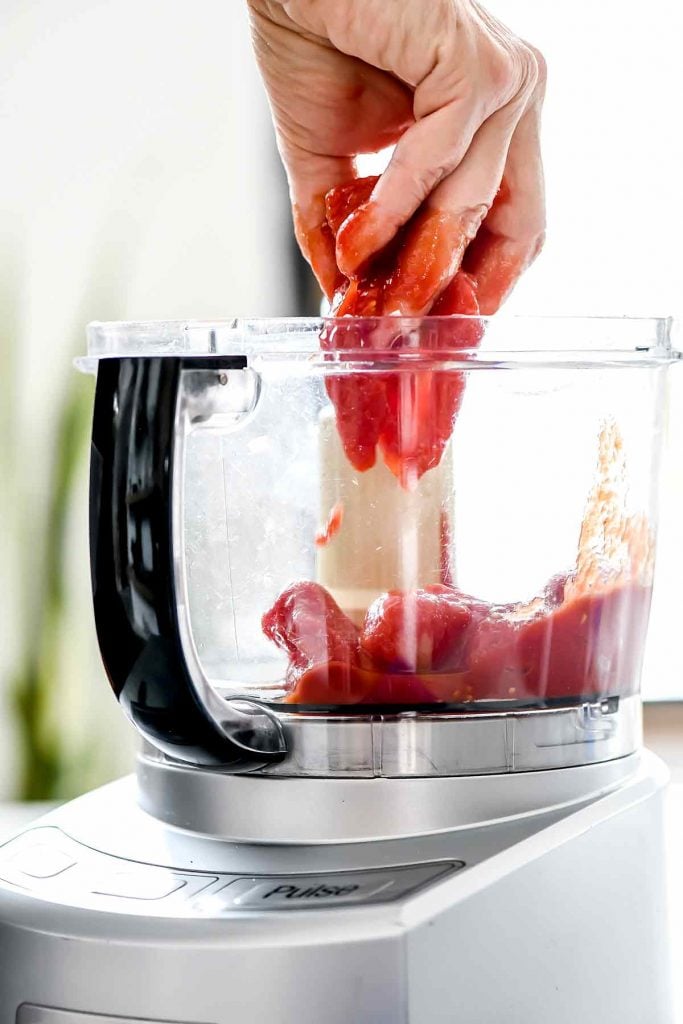
Types of Tomatoes in This Bolognese Sauce Recipe
- Canned San Marzano tomatoes. The best sauce calls for the best ingredients and that means using certified Italian San Marzano tomatoes. Be sure to choose legit San Marzano tomatoes that are canned whole in a sauced tomato purée. I use DeLallo San Marzano style tomatoes that are grown in Italy and imported to the U.S. Interestingly, 95% of the San Marzano tomatoes sold in the U.S. aren’t actually from Italy as they claim, and are actually grown in the U.S. instead.
- Tip: Look for the D.O.P on the can’s label to know if you’re getting real San Marzanos (it stands for “Denominazione di Origine Protetta” which translates to Protected Designation of Origin.
- For more flavor, use less processed whole tomatoes in purée. I prefer this route versus using crushed tomatoes. Pulse the whole tomatoes in a food processor or blender until smooth, or pass through a food mill.
- Tomato paste. Tomato paste is concentrated tomato and adds depth to this sauce. Cooking the paste with the meat deepens the flavor and removes the raw flavor of the concentrated tomato.
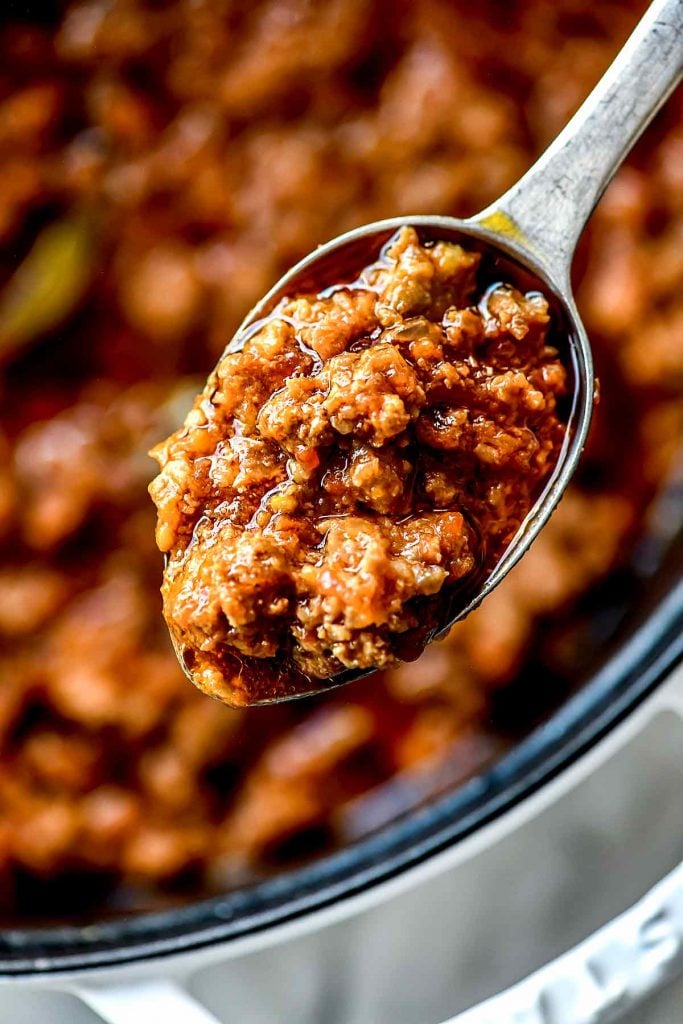
How to Make Bolognese Sauce
When making the classic Italian bolognese, plan on at least 3 hours of cooking time, or even longer. This sauce is best after a long, slow simmer for the flavors to develop. And it’s just as good if not better the next day. That’s what makes it totally worth waiting for.
- Cook the mirepoix or soffrito mixture of onion, celery, and carrot in butter. A fine mince of sautéed vegetables is one of the signatures of bolognese. Cooked in butter, they provide the starting point for flavoring the meat sauce. Note, that there is no garlic in traditional bolognese.
- Blitz the tomatoes and pancetta. Add the tomatoes and their juices to the food processor and blitz until smooth. Transfer to a bowl, wipe out the food processor, and pulse the pancetta into a coarse paste.
- Lightly brown the meats, cooking just until the meat loses its raw edge. Some pink in the middle is okay. The rawness will cook out as the sauce simmers on the stove.
Add the Umami
- Stir in the tomato paste, cooking to add umami and deepen flavor. Add the tomato paste directly to the meat and cook until the tomato paste loses its raw tomato tang.
- Add the wine and cook until absorbed, then add milk and simmer until almost dry. Use your choice of white or red wine, and cook into the meat mixture, scraping up any browned bits from the bottom of the pot. After the wine is absorbed, pour in the milk, and simmer until it evaporates, stirring as it tenderizes the meats.
- Add tomatoes, aromatics, and beef broth, chicken broth or stock. Adding broth/stock to the tomatoes keeps the sauce moist and juicy during its long simmer as the meats braise. If the sauce seems dry, add ¼ cup hot water as needed to loosen the sauce so it isn’t dry.
- Simmer the bolognese meat sauce with the lid off for 2 ½ to 3 hours. Stirring occasionally, cook the sauce uncovered over a low simmer for the sauce and meats to become one. The sauce will reduce and thicken as it cooks.
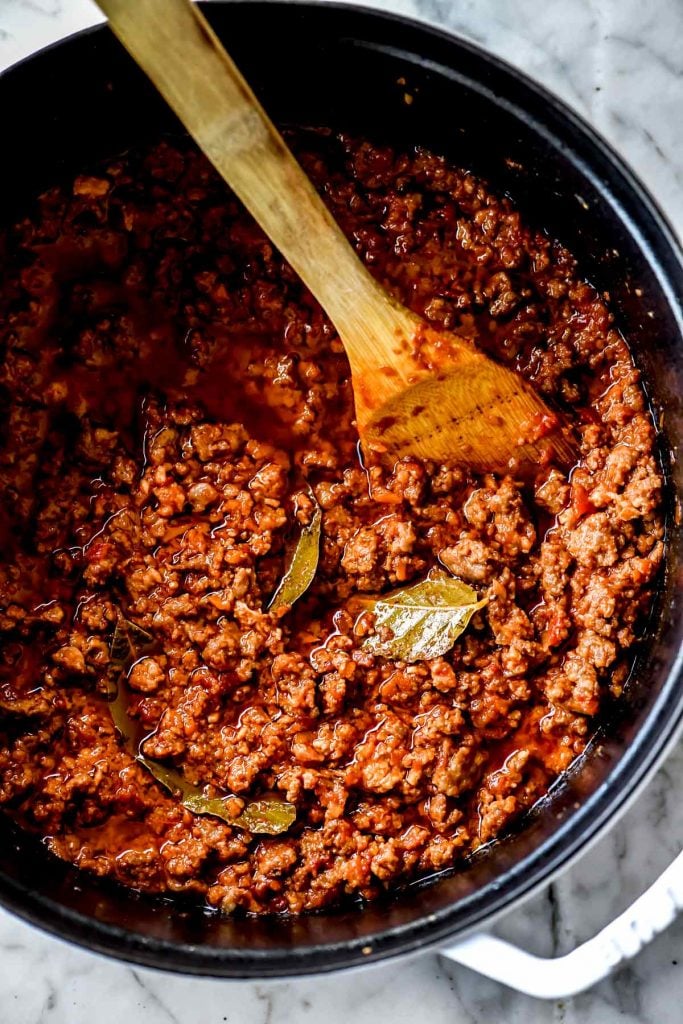
It’s Ok! The Fat Should Separate from the Sauce
Fat adds flavor, and it’s a very important part of this sauce. As the sauce reduces, you’ll likely notice a layer of oil that floats to the top. Spoon off if desired, or for a more velvety feel, stir it back in before serving where it will help the sauce stick to the pasta.
How to Freeze Bolognese
Making a big batch of bolognese is a great idea for batch cooking and meal prepping. Portion out into Ziploc freezer bags, squeeze out all of the air, and freeze for up to 3 months.
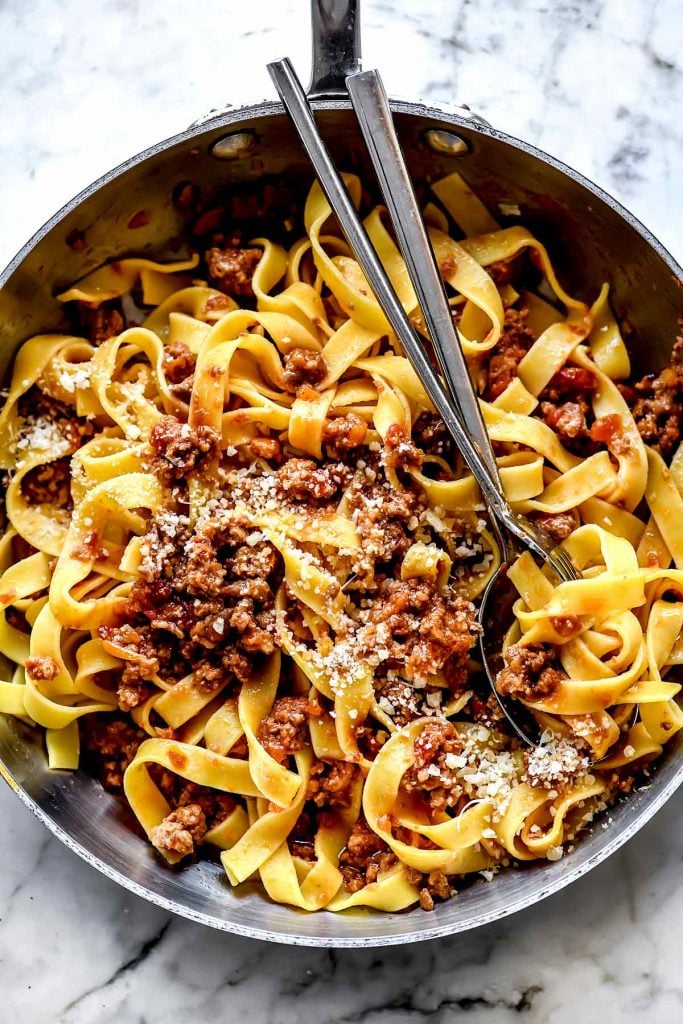
What to Serve With Bolognese
This sauce makes enough to dress 1 ½ to 2 pounds of pasta.
So what kind of pasta is best? I like serving this bolognese over long, wide noodles like egg-based pappardelle, or tagliatelle, fettuccine, or spaghetti, or use it to top penne or rigatoni.
The BEST Bolognese Sauce Recipe
Ingredients
- 3 tablespoons extra virgin olive oil
- 3 tablespoons butter
- 1 yellow onion roughly chopped into 1-inch pieces
- 1 celery stalk roughly chopped into 1-inch pieces
- 1 carrot peeled and roughly chopped into 1-inch pieces
- 1 28- ounce can whole San Marzano tomatoes in juice about 3 cups
- 8 ounces pancetta cut into ½-inch chunks
- 2 tablespoons tomato paste
- 1 pound 80/20 blend ground chuck beef
- 1 pound ground pork
- ½ teaspoon red pepper flakes
- ½ cup dry white wine
- 1 cup whole milk 2% milk fat can be substituted
- 2 cups beef or chicken broth
- 3 bay leaves
- 1 teaspoon kosher salt
Instructions
- In a large Dutch oven or heavy bottom pot, add the olive oil and butter over medium heat. In a food processor, pulse the onion, celery, and carrot until finely chopped. Cook, stirring occasionally, until the vegetables are soft and golden, about 5-7 minutes.
- While the vegetables are cooking, add the tomatoes with their juice to the food processor and pulse 5-7 times until smooth. Transfer to a bowl and set aside. Wipe out the food processor, then add the pancetta to the bowl. Pulse until the pancetta is a coarse paste. Set aside.
- Add the ground chuck, pork, and pancetta to the Dutch oven, along with the red pepper flakes. Use a wooden spoon to break the meat apart as it cooks, just until lightly browned so the meat loses its raw edge. Add the tomato paste and cook for about 10 minutes until the paste begins to brown, stirring when needed so it doesn’t burn.
- Add the wine and cook until the wine is almost all absorbed, about 10 minutes, stirring to scrape up any browned bits. Add the milk and cook until it has evaporated, which will take about 30 minutes, stirring and breaking up the meat more as it cooks.
- Add the tomatoes, broth, bay leaves, and kosher salt. Bring to a simmer then reduce the heat to the lowest setting so it cooks with barely a bubble breaking the surface occasionally. Cook for 2 ½ to 3 hours until the meat is tender and the sauce has reduced and thickened to become rich and dark in color. Toward the end of cooking, a layer of oil will likely rise to the top. Spoon off the oil or fold back into the sauce as desired. The longer you cook the sauce the better it will become. If the sauce seems to dry out, add ¼ cup hot water at a time as needed.
- Serve the sauce over wide egg or pasta noodles such as pappardelle, tagliatelle, fettuccine, or rigatoni. Serve topped with fresh grated Parmesan cheese/
Notes
Leftover sauce can be frozen for up to 3 months.

